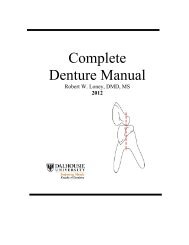RPD Manual 11 - Removable Prosthodontics - Dalhousie University
RPD Manual 11 - Removable Prosthodontics - Dalhousie University
RPD Manual 11 - Removable Prosthodontics - Dalhousie University
Create successful ePaper yourself
Turn your PDF publications into a flip-book with our unique Google optimized e-Paper software.
Jaw Relations, Altered Cast Technique and Wax Try-in - 91<br />
7. The denture is placed intraorally to assess occlusion, vertical dimension, esthetics,<br />
phonetics, and comfort.<br />
8. A laboratory prescription form (for acrylic processing) and the articulator with mounted<br />
models are sent to the laboratory for processing.<br />
Altered Cast Impressions<br />
Since frameworks made from master casts must be adjusted to fit intraorally, the relationship of<br />
the teeth and denture base can change from that observed on the master cast. In tooth-borne<br />
partial dentures this small change is negligible since the teeth provide almost the entire support<br />
for the denture. In distal extension cases, however, the change can produce deleterious effects<br />
on the supporting residual ridge and/or teeth, since the load must be distributed between the two<br />
tissues. For this reason, a new impression (altered cast impression) is made with the partial<br />
denture framework (after intraoral adjustment) so as to capture an accurate relation between the<br />
teeth, framework and residual ridge.<br />
Tooth and Tissue-Borne <strong>Removable</strong> Partial Dentures<br />
Since the relationship of the framework to the soft tissues may change in a tissue-borne partial<br />
denture, it is necessary to re-relate the framework to the supporting mucosa. This is<br />
accomplished by attaching a small custom tray over the meshwork of the edentulous ridge, by<br />
border molding the tray for proper extension and then making a new impression of the residual<br />
ridge. The steps in this procedure are as follows:<br />
1. The tentative outline of the denture base is drawn on the master cast with the framework in<br />
place. This will permit greater accuracy in tray extension.<br />
2. Remove the framework and place one thickness of baseplate wax spacer over the<br />
edentulous ridge.<br />
3. Grasp the framework with a hemostat or similar instrument and heat the meshwork over a<br />
flame. While the framework is still hot, replace it over the master cast. Press to place with<br />
a mirror handle, paper towels etc. to ensure you do not burn yourself. It is extremely<br />
important that the framework fully seat at this stage. If it does not, the wax will prevent<br />
full seating of the framework at the border molding, and possibly, the impression stage.<br />
This would produce exactly the opposite effect that we wish to obtain (i.e. it would impair<br />
the framework/tissue relation rather than improve it). To ensure the framework is fully<br />
seated inspect it for the following:<br />
a. tissue stop(s) should be entirely through the spacer(s)<br />
b. the metal in region 1.5 -2 mm adjacent to the edentulous span should be entirely<br />
through the spacer(s)<br />
c. there should be no resistance felt as mesh melts through wax<br />
d. rests should be fully seated in their rest seats<br />
4. With a #7 wax spatula, remove wax from 6-7 of the holes in the meshwork. Leave<br />
meshwork slightly undercut so acrylic tray can lock onto it.















